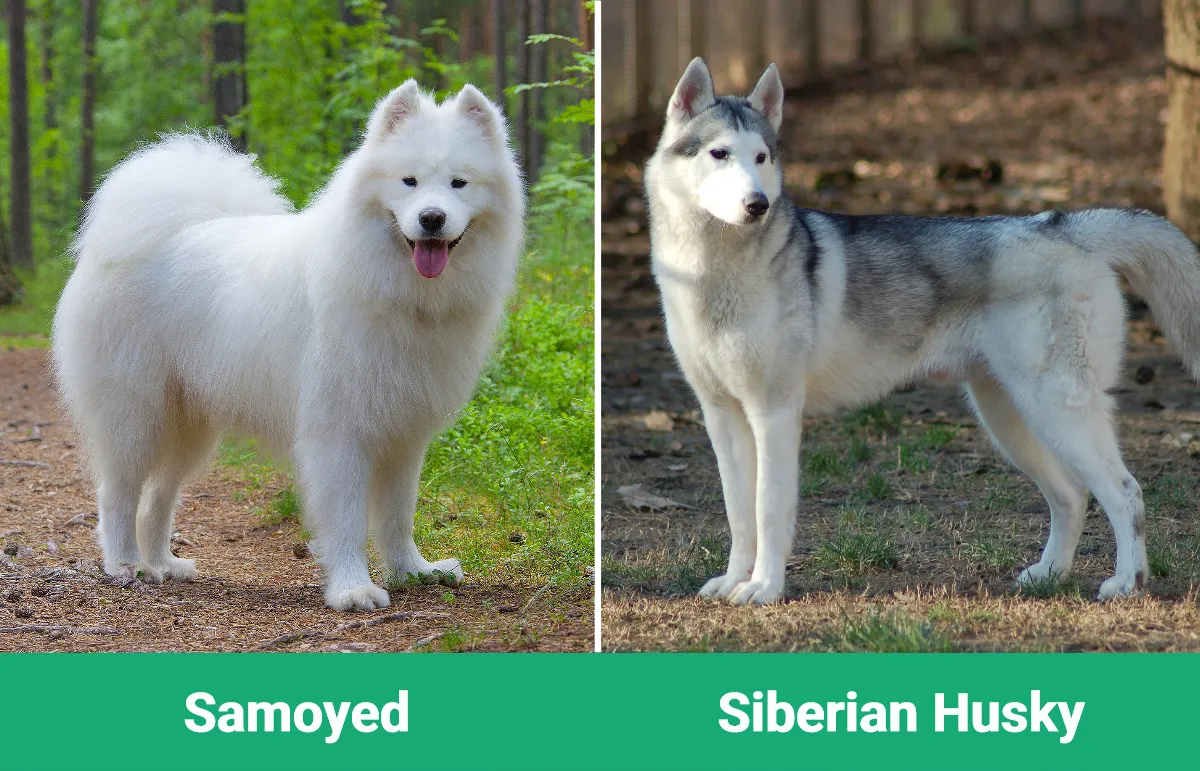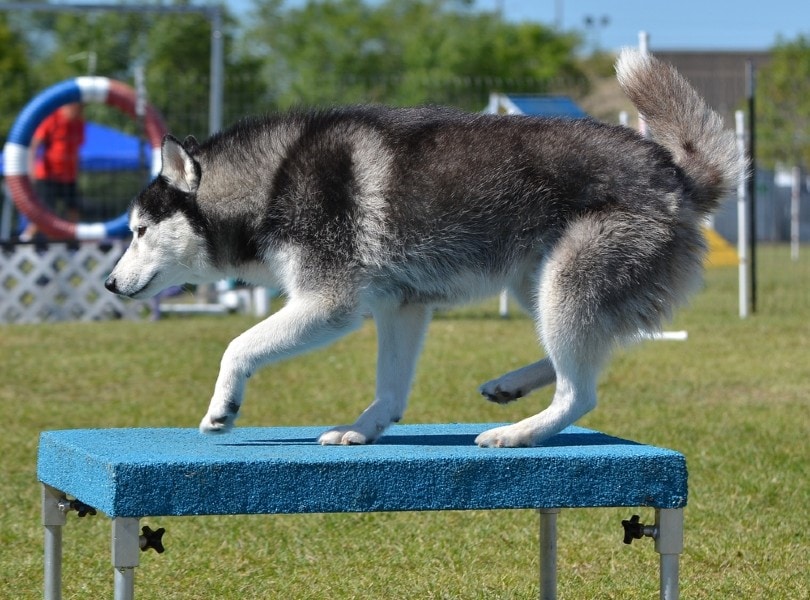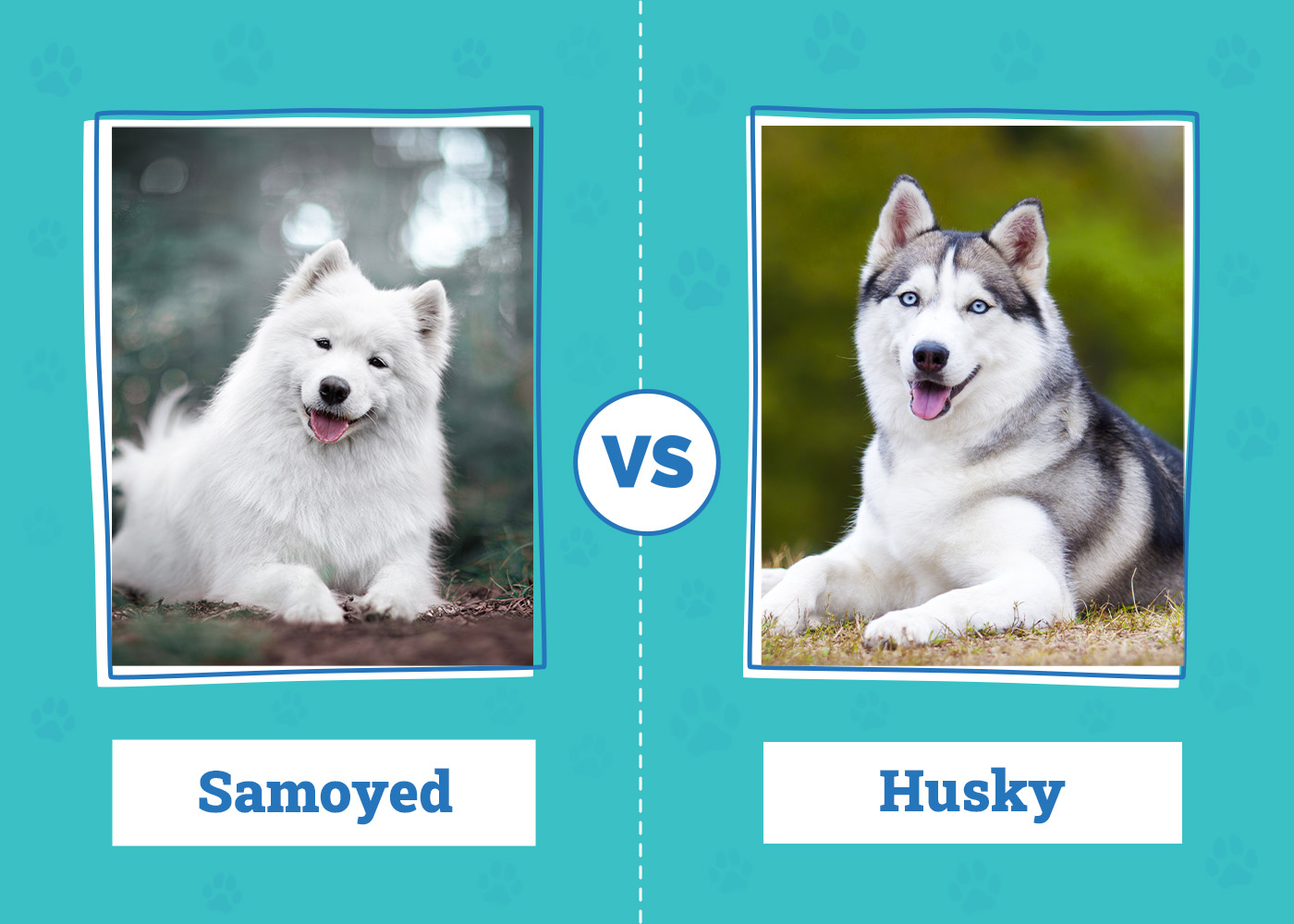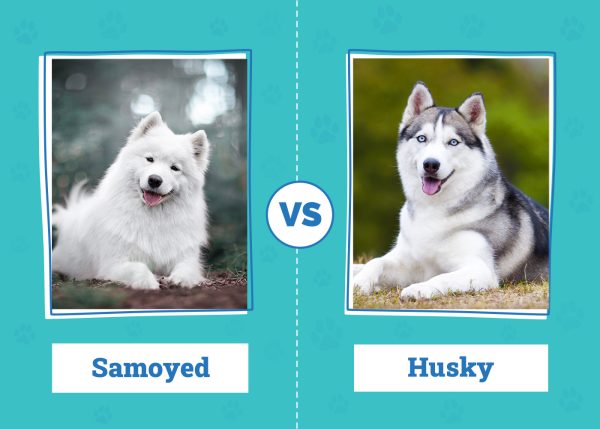Click to Skip Ahead
Let’s take a closer look at two of the cutest and most popular dog breeds out there: Samoyeds and Siberian Huskies. These furry buddies have a lot in common, but they are not the same! They both hail from the northwestern region of Russia, where they had to develop a thick double coat to withstand the harsh winters.
Both breeds have been known to help humans by pulling sleds, whether for nomads, explorers, or dog sled racing. Are you curious to find out more about the differences between these two adorable breeds? Then keep reading!
Visual Differences

At a Glance
- Average height (adult): 19–23.5 inches
- Average weight (adult): 35–65 pounds
- Lifespan: 12–14 years
- Exercise: 2+ hours a day
- Grooming needs: Moderate
- Family-friendly: Yes
- Other pet-friendly: Often
- Trainability: Intelligent, eager to please
- Average height (adult): 20–23.5 inches
- Average weight (adult): 35–60 pounds
- Lifespan: 12–14 years
- Exercise: 2+ hours a day
- Grooming needs: Moderate
- Family-friendly: Yes
- Other pet-friendly: Very
- Trainability: Intelligent but stubborn
Samoyed Overview

Have you ever seen a Samoyed with a coat of pure white fur? It’s a breathtaking sight to behold! These arctic dogs are a true marvel. From their adorable triangular ears to their sweeping, curved tails, they look like a pristine snowdrift in the middle of a Nordic landscape. As well as solid colors of cream and biscuit, purebred Samoyeds also come in beautiful combinations of white and biscuit.
Depending on where you live, you might hear it as Sa-moy-ed, Sammy-ed, or Samm-ah-yed. All of these are correct, but many simply call them “Sammies” or “Sams” for short. They’re outgoing, intelligent, and cheerful dogs that are always up for some fun. And don’t let their playful nature deceive you—these snowballs of energy also have a tenacious work ethic!
Personality
This breed is known for their fun-loving nature with both family and strangers. Plus, they’re great with kids and other pets. With a history of herding, Samoyeds typically only require basic socialization to maintain their friendly personalities. However, due to their prey drive, it’s important to train them to curb their instinct to chase smaller dogs or cats.

Diet and Nutrition
If you’re a proud Samoyed parent, you know how important it is to feed your furry friend right. Keeping things simple, make sure to feed your pup high-quality dog food twice a day. In addition, be careful about any weight gain; just like humans, Samoyeds can pack on the pounds if they overeat. So, adjust their portions accordingly.
Chat with your vet if you need help figuring out where to start. They can assist you in coming up with a diet plan that’s just right for your pup based on their age, weight, and activity level. And if there are any food allergies or tummy troubles, they can help you adjust to keep your furry friend feeling great.
Of course, don’t forget about hydration. Ensure your pup has access to plenty of water throughout the day to stay energized and feel their best.
Exercise
These furry friends require a lot of exercise to stay happy and healthy. In fact, they need at least 2 hours of activity every day, whether it’s long walks, running, or active play sessions.
But it’s not just about working out. Sammies also crave one-on-one bonding time with their owners. They love nothing more than spending quality time with their humans! If they don’t get enough attention, they might start acting out due to boredom and frustration. That’s why paying extra attention to this breed is crucial to keep them stimulated. And here’s a fun tip: Sammies get along well with other dogs, so having a furry playmate is a great way to ensure they’re getting enough exercise and socialization.

Training
Training these fluffy pups can be a breeze, but they have a stubborn side. Once the basics are covered, your Sammie will be eager to please and form a strong bond with you. Starting obedience lessons as early as 7–8 weeks old is key to assuring your pup understands their role and maintains good behavior.
Plus, the Samoyed’s working history means they love to learn and pick up new skills with ease. If you want to maximize your Samoyed’s natural talents, try incorporating agility, nose work, or herding into your training routine. These lessons may take a bit of extra patience, but it’s worth it!
Grooming
These fluffy dogs are adorable and loyal, but their beauty comes with a price—they shed a lot. But don’t fret, though. You can keep your Sammy looking and feeling their best with a little effort.
Samoyeds have a double coat, which means dirt and debris can easily get tangled up in their fur. Regular brushing is super important, especially during their peak shedding seasons (which happen twice a year).
While you can certainly take care of your Sammy’s grooming needs at home, it’s a good idea to take them to a professional groomer every so often to make sure they’re getting a thorough clean. You’ll also need to brush their teeth, trim their nails, and clean their ears to prevent any infections.

Suitable For:
If you’re looking for a furry friend who’s always up for some fun, you should consider getting a Samoyed! These high-energy pups love nothing more than spending time with their human friends and are always eager for a new adventure.
However, because Samoyeds need a lot of exercise and mental stimulation, they’re best suited for owners who have plenty of time to play and train with them. But don’t worry; the effort is totally worth it! Whether tossing a ball around in the park or just cuddling up on the couch, your Samoyed will be your loyal and loving companion through it all.
Husky Overview

Are you ready for a fun-loving, mischievous companion who’s born to run? Great! Siberian Huskies are always ready for a good time and need an active owner to keep up with their energy levels. And for that reason, a secure yard is a must to ensure their safety while they play and explore.
These dogs do love the cold and snow. With their dense double coats, they’re built to move and play all day in the winter’s chill. Huskies are also independent and intelligent, making them a welcoming addition to many households. As pack animals, they thrive on social interaction, both with their human companions and other medium- to large-size canines.
Personality
These guys are all about having fun and spreading joy wherever they go. But fair warning: they can be a handful and need an owner who’s ready to keep up with them both physically and mentally. However, the love and companionship they provide are worth every second of effort. Plus, if you’ve got other pets at home, Siberian Huskies are super social and love making new friends, so they’ll fit right in.

Diet and Nutrition
Did you know that Huskies were bred to need less food than some other breeds of the same size? To keep your furry friend healthy and happy, feed them two meals daily, each consisting of up to one cup of dry dog food. Remember that their specific dietary needs may vary based on age, size, and activity level, so discussing their nutritional requirements with your veterinarian is always a good idea. Monitor your dog’s weight to prevent obesity and ensure they live their best lives!
Exercise
Huskies are full of energy and love to stay active. While running is a great way to keep your pet fit, you also need to be mindful of the weather. They can overheat quickly, so when the temperature rises, it’s time to get creative with indoor exercise. Just be prepared for some digging if you leave your Husky outside for too long. Unfortunately, a bored Husky can wreak havoc both indoors and out, so keep them entertained and engaged!
Training
Huskies are one of the most energetic and intelligent dog breeds out there. They are known to be quite vocal, often expressing themselves through howling or whining. To keep these furry friends happy and healthy, they require a lot of training and exercise.
Huskies have an innate desire to explore and can be escape artists, so it’s crucial to keep them on a leash when going for walks. Additionally, they require a sturdy and tall fence to prevent them from jumping over and a protective barrier to keep them from digging their way out. With the proper training, your Husky can learn to channel their energy in a positive way. These playful pups can become out of control without enough exercise and training.

Grooming
When it comes to shedding, these furry friends need some extra attention. They typically shed minimally throughout the year, but for about 3 weeks, they “blow their coat” and shed quite a bit. So, be prepared for extra cleaning during that time, and brush them thoroughly once or twice a week. Despite their shedding, Huskies are actually quite clean and don’t have a strong odor like some other breeds. You won’t need to bathe them often, but make sure to trim their nails regularly and brush their teeth a few times a week for good oral health.
Suitable For:
Huskies may not be the best fit for apartment living. These pups are full of energy and require plenty of room to roam and play, so they may find an apartment a bit too cramped for their liking.
Additionally, they tend to be quite vocal, which can annoy your neighbors if they bark while you’re out and about. However, a Siberian Husky can be an amazing companion if you’re an active family who loves spending time outdoors! Just be sure you have plenty of time and space to give them the necessary exercise and attention.
Which Breed Is Right for You?
A Samoyed and a Siberian Husky may look similar, but these dog breeds have distinct characteristics that set them apart. Huskies were bred for endurance and are known for their ability to pull sleds over long distances. On the other hand, Samoyeds are herding dogs at heart and have a solid white coat.
Both breeds have their own unique challenges and require experienced owners who can handle their energy and personalities. But don’t let that scare you away! With the proper care and attention, both Samoyeds and Siberian Huskies can be loyal and loving companions who will bring a lot of joy to your life.
Featured Image Credit: Top – Monika Hodanova, Shutterstock | Bottom – andrescarlofotografia, Pixabay












